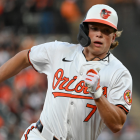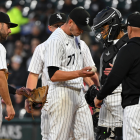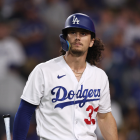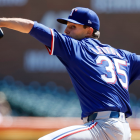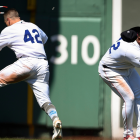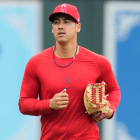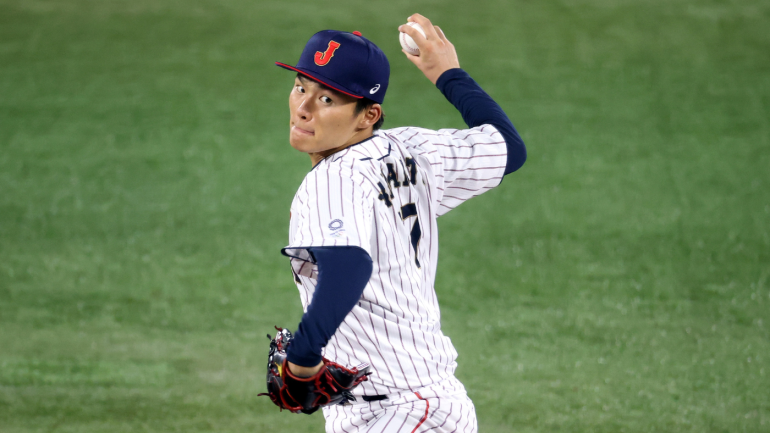
The 2023 World Baseball Classic, the first since 2017, will get underway on Tuesday, March 7. For many American viewers, the WBC will serve as an introduction to the top talents of other leagues, including Japan's Nippon Professional Baseball and South Korea's Korea Baseball Organization. A natural response, then, is to wonder if and when some of those players will make their way to Major League Baseball, the way others have over the years.
Of course, not everyone desires playing in MLB. Several top international talents have expressed interest in making the leap someday, however, and CBS Sports felt this would be a good opportunity to highlight some of the players worth keeping tabs -- for the duration of the WBC, and in the years to come. With that in mind, below you'll find background information, scouting notes, and arrival estimates for four particularly intriguing young players.
1. Yoshinobu Yamamoto, RHP, Japan (Orix Buffaloes)
Yoshinobu Yamamoto, Unfair Curveball...and Sword. ⚔️ pic.twitter.com/8Lqcl0lTxx
— Rob Friedman (@PitchingNinja) August 4, 2021
What's his deal? Yamamoto is arguably the best pitcher in Nippon Professional Baseball. Last season he won both the Pacific League Most Valuable Player and the Eiji Sawamura Award (think: Cy Young) after posting a 1.68 ERA and a 4.88 strikeout-to-walk ratio. Yamamoto is a four-time All-Star, a three-time ERA champion, and a two-time Triple Crown champion. For his career, he has a 1.84 ERA and a 4.31 strikeout-to-walk ratio in nearly 800 innings pitched.
How would his game transfer? The success of Shohei Ohtani, Yu Darvish, Masahiro Tanaka, Hiroki Kuroda, and numerous others has proven that NPB pitchers can handle themselves in MLB. Yamamoto would fit right in from a pitch-quality perspective. He has great command of a mid-90s fastball with carry, as well as a swing-and-miss splitter and a high-spin curveball. He would have to prove that his stuff -- especially his splitter -- plays the same with the baseball stateside, but again, there's enough precedent here to be optimistic about his chances. The other concern about him is his size, as he's listed at 5-foot-10 with a slight frame. Teams appear to be more favorable to shorter pitchers these days, however, thanks to the increased popularity of the vertical approach angle concept and the decreased expectations in starter workload. Yamamoto will likely be viewed as a No. 2 starter if and when he comes over.
When might he join MLB? The New York Post reported earlier this month that Yamamoto could be posted for MLB consideration after the 2023 season. At that point, Yamamoto will have succeeded in clearing the necessary MLB thresholds (25 years old, six years of service in a recognized professional league) to no longer be treated as an international amateur free agent.
2. Roki Sasaki, RHP, Japan (Chiba Lotte Marines)
Roki Sasaki's Wicked Splitters. 🤢 [20 years old] pic.twitter.com/ZxCinCnZAz
— Rob Friedman (@PitchingNinja) February 27, 2022
What's his deal? Sasaki, who just celebrated his 21st birthday in November, is the youngest of the four players presented here. He made global headlines last April after throwing a 19-strikeout perfect game. Sasaki finished the season with a 2.02 ERA and a 7.52 strikeout-to-walk ratio, with the latter fueled by a jaw-dropping 35 percent strikeout percentage. For comparison, Yamamoto last season struck out just over 27 percent of the batters he faced.
How would his game transfer? As noted in Yamamoto's capsule, there's a rich history of NPB pitchers coming over and making their mark. Sasaki certainly has the means to do it himself some day. He has a phenomenal fastball that sits in the upper-90s and features top-notch vertical life. Sasaki's other top offering is a splitter/forkball, though he has a pair of breaking balls, too. Again, he would probably earn No. 2 starter projections, but that's only because he's too young to have had a chance to establish himself as a durable workhorse. (Many evaluators are reluctant to designate someone an "ace" until they've established themselves at a high level over the course of several years.)
When might he join MLB? Sasaki is the farthest away of the four players on this list. He will not clear either of MLB's aforementioned thresholds until after the 2026 campaign, suggesting that 2027 would be his earliest arrival.
3. Munetaka Murakami, 3B, Japan (Yakult Swallows)
56 home runs for Munetaka Murakami! pic.twitter.com/eqMFOPicGD
— Codify (@CodifyBaseball) October 3, 2022
What's his deal? Murakami raised his global profile in a significant way in 2022, homering 56 times and shattering Sadaharu Oh's single-season record for a Japanese-born player. In parts of five seasons overall, he's batted .282/.402/.568 with 177 home runs and 500 runs batted in. Last year, he even saw his walk-to-strikeout ratio approach 1.0 (118 versus 128).
How would his game transfer? Sports Info Solutions tweeted in August that Murakami had an average exit velocity of 91 mph and an average launch angle of 13.6 degrees. In other words, Murakami hits it hard and on a line. It's hard to make a one-to-one comparison to any MLB hitter for obvious reasons, but Freddie Freeman and Corey Seager each had similar marks. Murakami has struck out around 20 percent of the time the last two seasons -- a rate likely to increase if and when he crosses the Pacific -- and evaluators are unsure if he'll remain at third for the long haul, or if he'll need to move across the diamond to first base. The upside here is a middle-of-the-order force with power and on-base skills. That's going to make him appealing to MLB teams regardless of his position.
When might he join MLB? Murakami signed a three-year extension with the Swallows back in December. He's expected to be posted at the conclusion of that contract, meaning he would be in line to debut in MLB come 2026.
4. Jung-hoo Lee, CF, Korea (Kiwoom Heroes)
RF Jung-hoo Lee with a double off a mistake pitch from Yamamoto. Lee, 22 years old, has a career .337 batting average and .403 in 5 years in the KBO with more walks than strikeouts, and can come to MLB in 2024. pic.twitter.com/HicImUsqYR
— Kyle Kishimoto (@kylemoto10) August 4, 2021
What's his deal? Lee, nicknamed "Grandson of the Wind" in a nod to his father, is the Korea Baseball Organization's reigning Most Valuable Player Award recipient. He's compiled a career .342/.407/.495 slash line with 59 home runs, 63 stolen bases, and 53 more walks than strikeouts while playing for the same club that employed San Diego Padres infielder Ha-Seong Kim.
How would his game transfer? MLB front offices are always skeptical about how KBO hitters will fare against better pitchers. (KBO is regarded as the world's third best league, behind MLB and NPB.) Lee ranks fourth because he's unlikely to evade that line of scrutiny. His boosters nevertheless envision him becoming a starting center fielder in MLB. Lee homered more times last season (23) than he had the previous two years combined (22), but his above-average contact chops are the safest component of his lefty bat. He's regarded as a plus runner and defender, a combination that should earn him a wider berth at the plate than the average bear. Lee may require some time to adjust to MLB (Kim, for example, raised his OPS 86 points in his second year stateside), so his secondary value would have to keep him afloat during his acclimation period.
When might he join MLB? The Heroes announced in January they will submit Lee to the posting system after the 2023 season. Barring an injury or some other unexpected development, he'll make his MLB debut in 2024.














